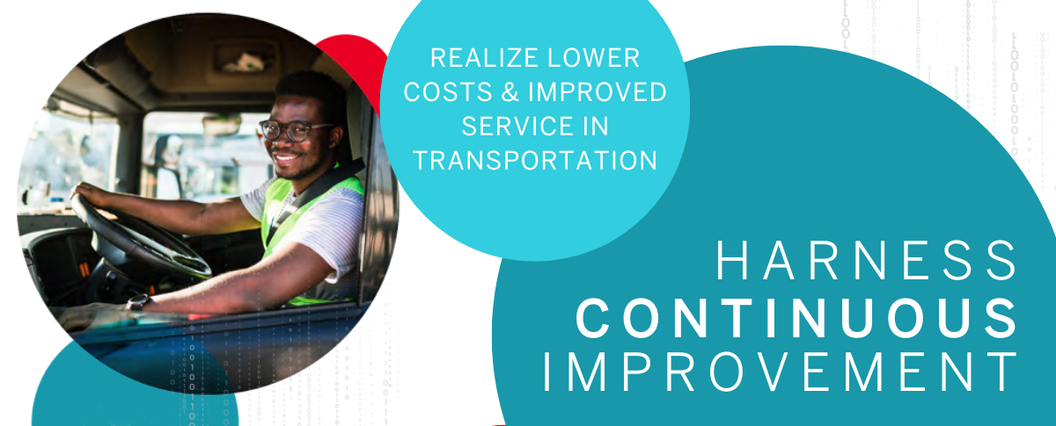
Itching to lower transportation and parcel costs? Or improve delivery service?
As it turns out, these common goals are well within reach for any company – on a regular basis.
It all starts with a continuous improvement mindset, or embracing the idea of making ongoing, incremental changes over time. This approach typically pushes teams to make more changes, more often, securing little wins that add up in big ways over time.
The good news? These types of wins are possible for any company at any time. The truth? Realizing these improvements requires a deep understanding of shipping and customer data, plus knowledge of what changes can help reduce costs, save time, and improve service.
So what exactly do you need to know to establish that knowledge? Let’s take a look at top focus areas for three critical points of improvement: Transportation, parcel, and service.
How to Achieve Continuous Cost Improvement
Any opportunity to lower costs is a no-brainer, especially when it comes to shipping, since doing so can improve margins. And as it turns out, evaluating both transportation and parcel costs on a regular basis – as frequently as quarterly or up to annually – can help reduce costs by a few percentage points with each evaluation.
Making these improvements all starts by gathering a set of baseline data for each area to understand current costs. You can then use that baseline as a point of comparison for different scenarios based on key areas that are typically ripe for improvement. Here’s how that breaks down for transportation and parcel costs.
Cost Improvement for Transportation
Baseline data to capture:
● Origins and destinations
● Shipment mode
● Freight class
● Pallet quantity
● Shipment weight
● Ship dates
Focus areas for improvement:
● Rate optimization: Ensure shipments move with the lowest cost carrier every single time.
● Load consolidation: Increase the average load size of a shipment.
● Mode optimization: Shift between modes (FTL, LTL, small parcel, etc.) based on which option provides the most cost efficiency.
● Delivery window
● Carrier mix
● Accessorials needed, if any
● Distribution optimization: Increase the efficiency of pickup and drop-off by reducing mileage.
● Network design: Ensure you have the right number of facilities in the right locations to serve your customers and receive inbound shipments.
Cost Improvement for Parcels
Baseline data to capture:
● Freight spend by mode
● Average shipping distance
● Average shipment weight
● Shipment quantity by weight breaks
● Delivered weight by state Focus areas for improvement:
● Additional handling and oversize surcharge reduction: Parcel dimensions are the number one area for most companies to find savings.
● Weight-to-carrier price optimization: Adjust methods based on the varying weight-based price models of different carriers and delivery modes.
● Zone optimization: Optimize distribution center location based on the distance a parcel needs to travel from pickup to delivery.
● Delivery service level audit: Audit delivery service levels used to avoid unnecessary spending and rate-shop for the service level actually needed.
● Carrier diversification: Use a mix of carriers (including national and regional) based on rates.
How to Achieve Continuous Service Improvement
Improving service can have an incredible impact on the customer experience, and it all starts with knowing your customers and what’s important to them. For example, do they value shipping speed or care more about a name-brand delivery?
In terms of shipping speed, the best way to achieve the fastest deliveries is to diversify the carrier mix. This allows for a variety of routes and pickup times, and as a bonus, can even lower costs.
But the tradeoff with optimizing for speed is that you sacrifice the name-brand delivery associated with national carriers. And if that’s what your customers care about most (which is often the case for people shopping from new companies and those purchasing expensive products), then it’s an entirely different equation.
Of course, there’s always a middle ground too. In the case of service improvement, perhaps the balance of speed and name-brand delivery service depends on the level of shipping customers select at checkout (e.g., free standard shipping vs. paid expedited shipping).
Don’t Underestimate the Value of Continuous Improvement
With the right approach, there are enormous savings to be found and service improvements to make on a regular basis.
But realizing that goal requires a deep understanding of the data and analytics behind transportation, parcel, and customer demands. And all of those data points are extremely nuanced and constantly in flux.
That’s where an expert partner like a 3PL that lives and breathes these data points on a daily basis and has a macro view of trends across the entire industry can make all the difference – providing the necessary expertise to deliver meaningful improvements time and again.
Ready to learn more about what it takes and how the right partner can help deliver ongoing improvements? Download our eBook, Driving Continuous Improvement with Data & Analytics, for the full details.

